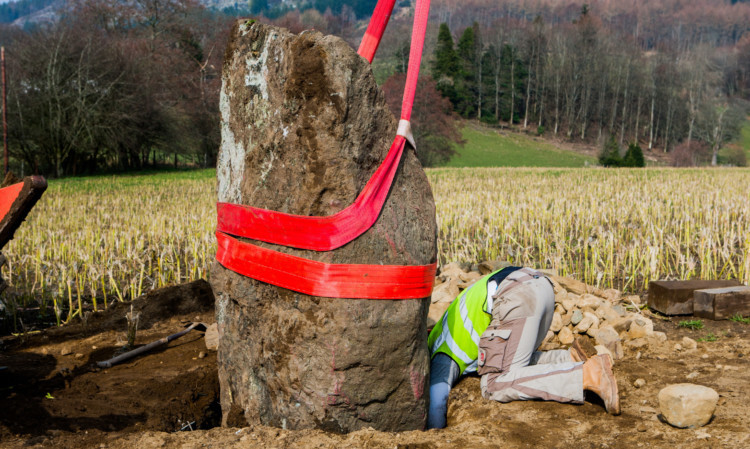It has taken several weeks, a team of experts and two diggers, but an ancient monument in Highland Perthshire is standing proud once again.
The Dane’s Stone has been returned to its rightful place in a Moulin field following a painstaking process.
Despite standing strong for up to 6,000 years, the monolith toppled over in February after days of heavy rain.
Studies of the site revealed that less than 20 inches of the huge stone, which is nearly seven-foot tall, remained underground at the time it fell.
Time and agricultural work had taken its toll on the site surrounding the stone, exposing more of the base each year.
In a bid to prevent this from happening again, a concrete pit has been created and about one third of the quartzite stone has been buried.
Oliver Lewis, senior heritage manager for Historic Scotland, told The Courier: “The height of the stone now is probably how high it was when it was first put up.
“Over the years, gradual agricultural improvements have removed the soil around it so, at the beginning of this year, around 2.1m (6.8ft) was above the ground and it was leaning.
“We have now set it deeper and I don’t think it will fall over again in our lifetime.”
Experts from Stockdale and Lyall Stonemasonry and CFA Archaeology Ltd oversaw the operation to put the monument back in position, which was paid for by Historic Scotland.
The same team have carried out similar works in the past and were employed in Fife, when the Peekie standing stone at Boarhills fell over, and in Angus in 2011, when the Carlinwell stone at Airlie toppled.
After being strapped to two diggers, the Dane’s Stone which weighs 4.5 tonne was carefully inched into place.
The restoration team looked on nervously as the machinery backed away and the ropes were loosened but, to their relief, the monolith remained upright.
Local residents also stopped to watch the work being carried out on Monday.
Mr Lewis said it was “nice” that the stone meant so much to the community and revealed several people had called Historic Scotland after it had fallen over.
He added: “It must have been of some importance when it was originally put in place and it’s nice that the present community cares about it so much.”
Regarded as a scheduled ancient monument, the Dane’s Stone is more than 6ft tall and boasts a rich history.
The field it stands in was the site of Moulin market the largest event of its kind in the area and deals made at the March event would be sealed with a clasping of hands by the stone.
The quartzite block is believed to date back to between 4,000BC and 1,000BC with the name given during the Middle Ages, around the time of the Vikings.
Very little is known about what the standing stone was used for, but similar structures are thought to have had ritual or religious significance.
